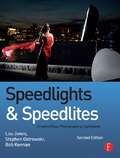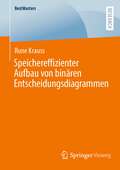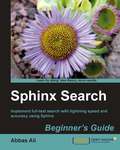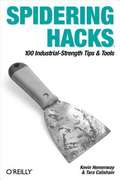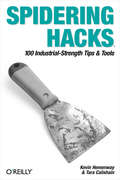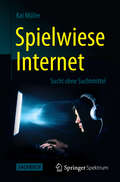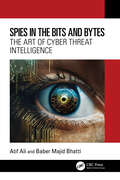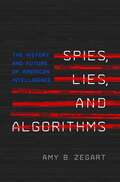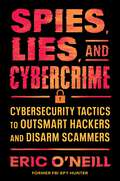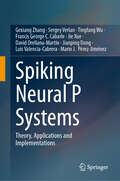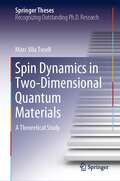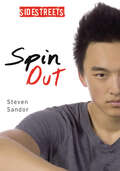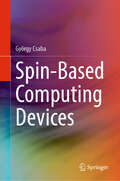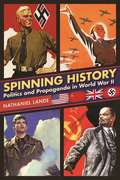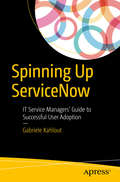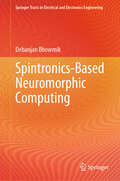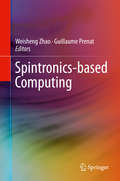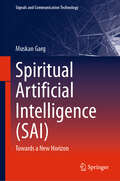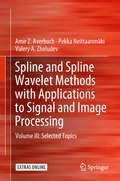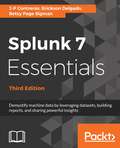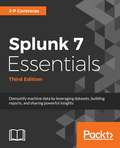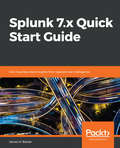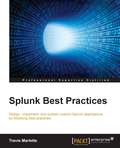- Table View
- List View
Speedlights & Speedlites: Creative Flash Photography at the Speed of Light
by Lou JonesCanon Speedlites and Nikon Speedlights are small, off-camera flashguns that can provide big results - if you know how to use them properly. Acclaimed Boston photographers Lou Jones, Bob Keenan and Steve Ostrowski guide you through the technical and creative aspects of how to get the most out of these powerful tools in this indispensable guide, packed full of inspirational images and comprehensive diagrams of the lighting set ups used to capture them. They are significantly more advanced, lighter and considerably cheaper than a standard flashgun, and have many advantages. They are small (and cheap) enough that a number can be carried in your kit, and they can be used in combination, triggered wirelessly. They use through-the-lens (TTL) metering, which allows you to use the in-camera LCD and histograms to calculate the required power/direction, rather than havng to use a light meter or trial and error. They use proprietary, dedicated technology (from Canon and Nikon) that means there are no compatability issues. Getting the most out of them, however, remains a mystery - most photographers still just use their speedlights in the same way as a standard flash gun. This is where this book comes in.
Speichereffizienter Aufbau von binären Entscheidungsdiagrammen (BestMasters)
by Rune KraussAufgrund der steigenden Komplexität von Hardwaresystemen besteht die Notwendigkeit, effizientere Datenstrukturen und darauf operierende Algorithmen zu entwickeln, um weiterhin das korrekte Verhalten solcher Systeme zu garantieren. Ein binäres Entscheidungsdiagramm ist eine geeignete Datenstruktur, da sie eine kompakte Repräsentation boolescher Funktionen und effiziente Algorithmen zur Manipulation dieser bietet. Allerdings haben Entscheidungsdiagramme auch Herausforderungen zu bewältigen: Die Praktikabilität hängt von deren Minimierung ab und es besteht ein großer Speicherbedarf für einige komplexe Funktionen. Dieses Buch präsentiert Ansätze, in denen boolesche Normalformen unter Ordnungsdefinitionen und Gesetzen der booleschen Algebra mit dem Ziel angeordnet werden, die Anzahl an Zwischenberechnungen zum Aufbau binärer Entscheidungsdiagramme zu verringern und den Speicher- sowie Zeitbedarf zu reduzieren. Die Methoden werden in ein Softwarepaket integriert, um die Performanz anhand von Benchmark-Instanzen zu untersuchen und mit dem Stand der Forschung zu vergleichen.
Spelunky (Boss Fight Books)
by Derek YuWhen Derek Yu released Spelunky for free in 2008, his roguelike-inspired platformer took the indie game community by storm with its combination of classic platform mechanics, extreme difficulty, and random level generation. Four years later, Spelunky's HD remake went on to become PC Gamer's Game of the Year and earn perfect scores from Polygon and Eurogamer. But how is a perfect game made? Spelunky is Boss Fight's first autobiographical book: the story of a game's creation as told by its creator. Using his own game as a vehicle, Derek Yu discusses such wide-ranging topics as randomization, challenge, indifferent game worlds, player feedback, development team dynamics, and what's required to actually finish a game. Grab some ropes, a mattock, and your favorite pug—this book is going to dig deep.
Sphinx Search Beginner's Guide
by Abbas AliThis book is a step-by-step guide for an absolute beginner. It covers everything, from installing to configuring, to get you started quickly. It has numerous code examples that the reader can try on their own and learn while doing so. It has two full-fledged applications as examples that readers can follow. This book is specifically focused on the Search feature of web applications.This book is for developers who are new to Sphinx Search. All code examples use PHP but the logic is same for any other web scripting languages as well.
Spider Man Unlimited Guia Não-Oficial
by João Wolf Joshua Abbott*Guia Não-Oficial* Dicas Avançadas e Guia de Estratégias. Este é o mais completo e o único guia detalhado que você encontrará on-line. Disponível para download instantâneo no seu celular, leitor de eBook, ou em forma impressa. Veja o que você irá receber ao adquirir este detalhado e avançado guia profissional de games. - Dicas e Estratégias Profissionais. - Formas de Trapacear. - Segredos, Dicas, Formas de Trapacear, Itens Desbloqueáveis, e Truques utilizados por Jogadores Profissionais! - Como Coletar Toneladas de Moeadas. - E MUITO MAIS! Aviso Legal: Este produto não é associado, afiliado, aprovado, certificado ou patrocinado pelo detentor original do Copyright. Todas as Marcas e Marcas Registradas que aparecem neste eBook são de propriedade dos seus respectivos donos.
Spidering Hacks
by Kevin Hemenway Tara CalishainWritten for developers, researchers, technical assistants, librarians, and power users, Spidering Hacks provides expert tips on spidering and scraping methodologies. You'll begin with a crash course in spidering concepts, tools (Perl, LWP, out-of-the-box utilities), and ethics (how to know when you've gone too far: what's acceptable and unacceptable). Next, you'll collect media files and data from databases. Then you'll learn how to interpret and understand the data, repurpose it for use in other applications, and even build authorized interfaces to integrate the data into your own content.
Spidering Hacks: 100 Industrial-Strength Tips & Tools
by Tara Calishain Morbus IffThe Internet, with its profusion of information, has made us hungry for ever more, ever better data. Out of necessity, many of us have become pretty adept with search engine queries, but there are times when even the most powerful search engines aren't enough. If you've ever wanted your data in a different form than it's presented, or wanted to collect data from several sites and see it side-by-side without the constraints of a browser, then Spidering Hacks is for you.Spidering Hacks takes you to the next level in Internet data retrieval--beyond search engines--by showing you how to create spiders and bots to retrieve information from your favorite sites and data sources. You'll no longer feel constrained by the way host sites think you want to see their data presented--you'll learn how to scrape and repurpose raw data so you can view in a way that's meaningful to you.Written for developers, researchers, technical assistants, librarians, and power users, Spidering Hacks provides expert tips on spidering and scraping methodologies. You'll begin with a crash course in spidering concepts, tools (Perl, LWP, out-of-the-box utilities), and ethics (how to know when you've gone too far: what's acceptable and unacceptable). Next, you'll collect media files and data from databases. Then you'll learn how to interpret and understand the data, repurpose it for use in other applications, and even build authorized interfaces to integrate the data into your own content. By the time you finish Spidering Hacks, you'll be able to:Aggregate and associate data from disparate locations, then store and manipulate the data as you likeGain a competitive edge in business by knowing when competitors' products are on sale, and comparing sales ranks and product placement on e-commerce sitesIntegrate third-party data into your own applications or web sitesMake your own site easier to scrape and more usable to othersKeep up-to-date with your favorite comics strips, news stories, stock tips, and more without visiting the site every dayLike the other books in O'Reilly's popular Hacks series, Spidering Hacks brings you 100 industrial-strength tips and tools from the experts to help you master this technology. If you're interested in data retrieval of any type, this book provides a wealth of data for finding a wealth of data.
Spielwiese Internet: Sucht ohne Suchtmittel
by Kai MüllerInternetsucht ist eine moderne Form einer psychischen Problematik, die offensichtlich immer mehr Menschen etwas angeht, entweder direkt oder indirekt. Wie eine verschwommene Schimäre taucht dieses Schlagwort "Internetsucht" in den Medien auf. Zahlen von Betroffenen, Symptome und Auswirkungen dieses neuen Phänomens werden von unterschiedlichen Experten in unterschiedlicher Weise diskutiert und dennoch bleibt der Nicht-Fachmann nur allzu oft mit mehr Fragen als Antworten zurück. Dieses Buch soll dem Leser einen möglichst umfassenden Einblick vermitteln. Es vermittelt Antworten auf zentrale Fragen, wie z.B.: Was verbirgt sich hinter dem Begriff der Internetsucht? Wann ist ein Verhalten bereits Ausdruck einer Sucht? Welche Menschen sind als besonders gefährdet anzusehen? Welche Maßnahmen können ergriffen werden, um einer Internetsucht zu begegnen? Der aktuelle psychologische Kenntnisstand wurde hierzu nachvollziehbar aufbereitet und in einen engen praxisnahen Bezug gesetzt. Zielgruppen für dieses Werk sind alle, die sich über das Thema Spiel- und Internetsucht informieren möchten sowie alle, die selbst oder in ihrem familiären Umfeld oder Bekanntenkreis Menschen kennen, die davon betroffen sind. Nebenzielgruppe sind alle diejenigen, die im beruflichen Umfeld mit Betroffenen zu tun haben. Der Autor ist Diplompsychologe und arbeitet in der deutschlandweit einzigartigen Ambulanz für Spielsucht. Innerhalb seines beruflichen Umfeldes befasst er sich intensiv mit dem Thema der substanzungebundenen Abhängigkeitserkrankungen (Verhaltenssüchte), hier insbesondere mit der Internet- und Computerspielsucht sowie der Glücksspielsucht.
Spies in the Bits and Bytes: The Art of Cyber Threat Intelligence
by Atif Ali Baber Majid BhattiIn an era where digital security transcends mere convenience to become a pivotal aspect of our daily lives, Spies in the Bits and Bytes: The Art of Cyber Threat Intelligence by Dr. Atif and Dr. Baber emerges as a critical beacon of knowledge and understanding. This book delves into the shadowy world of cyber threats, unraveling the complex web of digital espionage, cybercrime, and the innovative defenses that stand between safety and digital chaos. Dr. Atif, leveraging his profound expertise in artificial intelligence and cybersecurity, offers not just an exploration but a comprehensive guide to navigating the tumultuous digital landscape. What sets this book apart is its unique blend of technical depth, real-world examples, and accessible writing, making the intricate world of cyber threats understandable and engaging for a broad audience.Key features of Spies in the Bits and Bytes include: In-depth Analysis of Cyber Threats: Unveiling the latest and most sophisticated cyber threats facing our world today. Cutting-Edge Defense Strategies: Exploring the use of artificial intelligence (AI) and machine learning in crafting dynamic cyber defenses. Real-World Case Studies: Providing engaging examples that illustrate the impact of cyber threats and the importance of robust cybersecurity measures. Accessible Insights: Demystifying complex cybersecurity concepts for readers of all backgrounds. Forward-Looking Perspectives: Offering insights into the future of cyber threats and the evolving landscape of cyber defense. This book is an essential resource for anyone keen on understanding the intricacies of cybersecurity and the critical role it plays in our interconnected society. From cybersecurity professionals, IT students, and corporate leaders to policy makers and general readers with an interest in the digital world, Spies in the Bits and Bytes serves as a comprehensive guide to the challenges and solutions in the realm of cyber threat intelligence, preparing its audience for the ongoing battle against digital adversaries.
Spies, Lies, and Algorithms: The History and Future of American Intelligence
by Amy B. ZegartA riveting account of espionage for the digital age, from one of America’s leading intelligence expertsSpying has never been more ubiquitous—or less understood. The world is drowning in spy movies, TV shows, and novels, but universities offer more courses on rock and roll than on the CIA and there are more congressional experts on powdered milk than espionage. This crisis in intelligence education is distorting public opinion, fueling conspiracy theories, and hurting intelligence policy. In Spies, Lies, and Algorithms, Amy Zegart separates fact from fiction as she offers an engaging and enlightening account of the past, present, and future of American espionage as it faces a revolution driven by digital technology.Drawing on decades of research and hundreds of interviews with intelligence officials, Zegart provides a history of U.S. espionage, from George Washington’s Revolutionary War spies to today’s spy satellites; examines how fictional spies are influencing real officials; gives an overview of intelligence basics and life inside America’s intelligence agencies; explains the deadly cognitive biases that can mislead analysts; and explores the vexed issues of traitors, covert action, and congressional oversight. Most of all, Zegart describes how technology is empowering new enemies and opportunities, and creating powerful new players, such as private citizens who are successfully tracking nuclear threats using little more than Google Earth. And she shows why cyberspace is, in many ways, the ultimate cloak-and-dagger battleground, where nefarious actors employ deception, subterfuge, and advanced technology for theft, espionage, and information warfare.A fascinating and revealing account of espionage for the digital age, Spies, Lies, and Algorithms is essential reading for anyone who wants to understand the reality of spying today.
Spies, Lies, and Cybercrime: Cybersecurity Tactics to Outsmart Hackers and Disarm Scammers
by Eric O'NeillNational security strategist and former FBI counterintelligence operative Eric O’Neill exposes how nefarious cybercriminals relentlessly attempt to access your data and wallet, and arms you with his proven tactics for spotting and neutralizing cyberthreats to protect yourself, your family, and your business.Cybercriminals, domestic and foreign, are launching attacks day and night using malware, phishing scams, deepfakes, artificial intelligence, and other unscrupulous schemes designed to steal your data and hold it hostage. When they win, it costs nations, businesses, and individuals trillions of dollars annually.It’s possible to fight back, but it’ll take more than a strong password. Drawing on his years of experience as an FBI spy hunter and national security strategist, Eric O’Neill casts light on these malicious actors’ tactics for stealing personal data and exploiting victims. Armed with this knowledge, O’Neill shares his method—called PAID—that you can use to defend yourself and stop attackers in their tracks:Prepare: Pinpoint your most critical data, identify where it resides and who can access it, and build your defenses around it.Assess: Continuously reassess your security and apply counterintelligence tactics to identify scams and cyberattacks..Investigate: Stay educated and hunt the threat before the threat hunts you.Decide: Using your new aptitude, make smart, rapid decisions under pressure..Written by a top expert in the field, Spies, Lies, and Cybercrime offers easy-to-follow steps for staving off cyberattacks, securing data, and keeping private information safe in an increasingly digital and dizzying world.
Spiking Neural P Systems: Theory, Applications and Implementations
by Tingfang Wu Gexiang Zhang Sergey Verlan Mario J. Pérez-Jiménez Jie Xue Francis George Cabarle David Orellana-Martín Jianping Dong Luis Valencia-CabreraSpiking neural P systems represent a significant advancement in the field of membrane computing, drawing inspiration from the communication patterns observed in neurons. Since their inception in 2006, these distributed and parallel neural-like computing models have gained popularity and emerged as important tools within the membrane computing area. As a key branch of the third generation of artificial neural networks, a fascinating research area of artificial intelligence, spiking neural P systems offer a captivating blend of theoretical elegance and practical utility. Their efficiency, Turing completeness, and real-life application characteristics, including interpretability and suitability for large-scale problems, have positioned them at the forefront of contemporary research in membrane computing and artificial intelligence. This state-of-the-art reference work is organized into three parts comprising twelve chapters. It thoroughly investigates the theoretical foundations, real-life applications, and implementations of spiking neural P systems. From fundamental principles to computational power and complexity, the theoretical aspects are explored, laying the groundwork for understanding their practical applications. Real-life applications span a diverse range of domains, including complex optimization, classification, fault diagnosis, medical image processing, information fusion, cryptography, and robot control. Additionally, the book discusses several software and hardware implementations that provide valuable insights into the practical deployment of spiking neural P systems. As the rapid development of spiking neural P systems continues to unfold, there is an increasing demand for a systematic and comprehensive summary of their capabilities and applications. This work serves as an invaluable resource for researchers, scholars, and practitioners interested in the theoretical underpinnings, algorithms, and practical implementation of artificial intelligence and membrane computing.
Spin Dynamics in Two-Dimensional Quantum Materials: A Theoretical Study (Springer Theses)
by Marc Vila TusellThis thesis focuses on the exploration of nontrivial spin dynamics in graphene-based devices and topological materials, using realistic theoretical models and state-of-the-art quantum transport methodologies. The main outcomes of this work are: (i) the analysis of the crossover from diffusive to ballistic spin transport regimes in ultraclean graphene nonlocal devices, and (ii) investigation of spin transport and spin dynamics phenomena (such as the (quantum) spin Hall effect) in novel topological materials, such as monolayer Weyl semimetals WeTe2 and MoTe2. Indeed, the ballistic spin transport results are key for further interpretation of ultraclean spintronic devices, and will enable extracting precise values of spin diffusion lengths in diffusive transport and guide experiments in the (quasi)ballistic regime. Furthermore, the thesis provides an in-depth theoretical interpretation of puzzling huge measured efficiencies of the spin Hall effect in MoTe2, as well as a prediction of a novel canted quantum spin Hall effect in WTe2 with spins pointing in the yz plane.
Spin Out (Lorimer SideStreets)
by Steven SandorBen Cheng used to live the good life—he had wealthy parents, lots of friends, and respect as an online gamer. But when his parents separate, Ben's life changes entirely. He moves to a small apartment with his mom, his dad is out of the picture, and his new schoolmates start teasing him for his family's fall from grace. All Ben has left is his virtual life, where he still reigns supreme as an online racing driver. But when Ben takes his mom's car out for a joyride and gets caught, and uses his mom's credit card without permission, his life starts to spin out. Distributed in the U.S by Lerner Publishing Group
Spin-Based Computing Devices
by György CsabaThis book provides readers with a single-source reference to the state of the art in domain-wall, nanomagnet and spin-wave-based computing devices, enabling them to provide additional computing functions and lower the power consumption of electronic devices by orders of magnitudes. Tutorial chapters gives a thorough introduction to the preliminaries and the theory behind spin-based devices, and additional chapters give an overview of the most promising spin-based computing concepts. This book is designed to be a &‘first read&’ for anyone interested in the field of spin-based (magnetic) computing devices. The author provides an overview of how information can be processed by single-domain nanomagnets, domain walls, spin-waves or spin torque oscillators. Both Boolean approaches (magnetic logic gates) and non-Boolean devices (image processing circuits, etc.) are discussed.
Spinning History: Politics and Propaganda in World War II
by Nathaniel LandeAn “original and insightful” look at World War II through the lens of theater, propaganda, and the most important performances in human history (Richard Cole, PhD). In this fascinating book, more relevant than ever in today’s political climate of “fake news” and “alternative facts,” bestselling author and historian Nathaniel Lande presents WWII as a drama staged and overseen by four contrasting masters: Roosevelt, Churchill, Hitler, and Stalin. Each man had his own script for elaborately produced campaigns of deception, winning hearts and minds on the frontlines and the home front. Each leader used all the tools at his disposal to promote his own narrative of the Second World War. Brilliantly conceived oratory was applied to underscore each vision. Impression management—the art of political spin—was employed to drive the message home. Each side employed uniforms, meticulously staged events, and broadcast their messages via all media available—motion pictures, radio broadcasts, songs, posters, leaflets, and beyond. The result of Lande’s exploration is “an illuminating, readable, and still very relevant account of the ways in which theatrical staging, dramatic storytelling, and message manipulation were key to the efforts of both sides during those turbulent years” (Richard Zoglin, senior editor, Time).
Spinning Up ServiceNow
by Gabriele KahloutLearn how to onboard ServiceNow ITSM tools by evangelizing, educating, and coordinating your organization's service desk, developers, and stakeholders. Drawing on his own story of lessons learned in spinning up the adoption of ServiceNow throughout the Al Jazeera Media Network, application architect Gabriele Kahlout shows IT service managers how to launch automated ServiceNow ticketing tools in seamless integration with their organization's existing email and Active Directory.Spinning Up ServiceNow: IT Service Managers' Guide to Successful User Adoption shows you how to orchestrate your IT service desks and developers to facilitate the adoption and consumption of IT services by all users, supporting their various business needs while optimizing human-computer interaction and minimizing stress and productivity loss arising from poor human-system design.What You'll LearnQuick-start ServiceNow in a matter of days with the minimum configuration required to start processing tickets via emailAvoid the teething problems that can spoil your users’ onboarding experience with ServiceNowAutomate the process of scaling up new teams into ServiceNowShape your users' experiences so that they retain their familiar bearings in email and Active Directory while welcoming the power of ServiceNow enhancementsCreate a strategy to avoid common pitfalls that sabotage ITSM programsWho This Book Is For IT managers charged with implementing ServiceNow ITSM suites in their organizations and business analysts determining the requirements for such implementation. The secondary readership is system administrators and developers involved in ITSM.
Spintronics-Based Neuromorphic Computing (Springer Tracts in Electrical and Electronics Engineering)
by Debanjan BhowmikThe book discusses almost all aspects of spintronics-based neuromorphic computing, starting from a very basic level, and will be of interest to both spintronics and neuromorphic computing communities. The chapters also cover most simulation and experimental studies reported recently by researchers worldwide on this topic. The book includes an introductory chapter on nanomagnetism and spin physics and another on neural network algorithms (covering both the machine-learning and neuroscience aspects of these algorithms). These introductory chapters will help the readers build their background and truly appreciate the recent research results on spintronics-based neuromorphic computing, presented in the later chapters of the book. Various numerical simulation exercises are also provided in the book.
Spintronics-based Computing
by Weisheng Zhao Guillaume PrenatThis book provides a comprehensive introduction to spintronics-based computing for the next generation of ultra-low power/highly reliable logic. It will cover aspects from device to system-level, including magnetic memory cells, device modeling, hybrid circuit structure, design methodology, CAD tools, and technological integration methods. This book is accessible to a variety of readers and little or no background in magnetism and spin electronics are required to understand its content. The multidisciplinary team of expert authors from circuits, devices, computer architecture, CAD and system design reveal to readers the potential of spintronics nanodevices to reduce power consumption, improve reliability and enable new functionality.
Spiritual Artificial Intelligence: Towards a New Horizon (Signals and Communication Technology)
by Muskan GargThis unique book delves into the convergence of artificial intelligence (AI) principles—rooted in scientific knowledge and technological advancements—with the concept of spiritual wellness, exploring their significance in our increasingly automated and digitized world. The author offers a synthesis of two domains often perceived as distinct, appealing to both technologists and spiritual thinkers. Beginning with an exploration of the definitions and scope of "spiritual AI," the book encourages the quantification of spiritual wellness, illustrated through examples from current literature. It sheds light on the evolution of the spiritual quotient, presenting it as an integration of intelligence quotient (IQ) and emotional quotient (EQ), enhanced by dimensions of spirituality. The discussion spans various application domains and delves into the mind's entanglement-like phenomena, raising critical questions: Can a machine truly attain consciousness? How do spiritual wellness and quantum mechanics intertwine? The author invites readers to ask their own questions, contemplate the boundless possibilities of spiritual AI, and challenge existing paradigms.
Spline and Spline Wavelet Methods with Applications to Signal and Image Processing: Volume III: Selected Topics
by Pekka Neittaanmäki Amir Z. Averbuch Valery A. ZheludevThis book provides a practical guide, complete with accompanying Matlab software, to many different types of polynomial and discrete splines and spline-based wavelets, multiwavelets and wavelet frames in signal and image processing applications. In self-contained form, it briefly outlines a broad range of polynomial and discrete splines with equidistant nodes and their signal-processing-relevant properties. In particular, interpolating, smoothing, and shift-orthogonal splines are presented.
Splunk 7 Essentials, Third Edition: Demystify Machine Data By Leveraging Datasets, Building Reports, And Sharing Powerful Insights, 3rd Edition
by J-P ContrerasThis book will uncover the new features in Splunk 7.
Splunk 7 Essentials, Third Edition: Demystify machine data by leveraging datasets, building reports, and sharing powerful insights, 3rd Edition
by Erickson Delgado J-P Contreras Steven Koelpin Elizabeth P SigmanTransform machine data into powerful analytical intelligence using SplunkKey FeaturesAnalyze and visualize machine data to step into the world of Splunk!Leverage the exceptional analysis and visualization capabilities to make informed decisions for your businessThis easy-to-follow, practical book can be used by anyone - even if you have never managed data beforeBook DescriptionSplunk is a search, reporting, and analytics software platform for machine data, which has an ever-growing market adoption rate. More organizations than ever are adopting Splunk to make informed decisions in areas such as IT operations, information security, and the Internet of Things.The first two chapters of the book will get you started with a simple Splunkinstallation and set up of a sample machine data generator, called Eventgen.After this, you will learn to create various reports, dashboards, and alerts. You willalso explore Splunk's Pivot functionality to model data for business users. Youwill then have the opportunity to test-drive Splunk's powerful HTTP Event Collector. After covering the core Splunk functionality, you'll be provided with some real-world best practices for using Splunk, and information on how to build upon what you've learned in this book.Throughout the book, there will be additional comments and best practicerecommendations from a member of the SplunkTrust Community, called"Tips from the Fez". What you will learnInstall and configure Splunk for personal use Store event data in Splunk indexes, classify events into sources, and adddata fields Learn essential Splunk Search Processing Language commandsand best practices Create powerful real-time or user-input dashboards Be proactive by implementing alerts and scheduled reports Tips from the Fez: best practices using Splunk features and add-ons Understand security and deployment considerations for taking Splunk to an organizational levelWho this book is forThis book is for the beginners who want to get well versed in the services offered by Splunk 7. If you want to be a data/business analyst or want to be a system administrator, this book is what you want. No prior knowledge of Splunk is required.
Splunk 7.x Quick Start Guide: Gain business data insights from operational intelligence
by James H. BaxterLearn how to architect, implement, and administer a complex Splunk Enterprise environment and extract valuable insights from business data.Key FeaturesUnderstand the various components of Splunk and how they work together to provide a powerful Big Data analytics solution. Collect and index data from a wide variety of common machine data sourcesDesign searches, reports, and dashboard visualizations to provide business data insightsBook DescriptionSplunk is a leading platform and solution for collecting, searching, and extracting value from ever increasing amounts of big data - and big data is eating the world! This book covers all the crucial Splunk topics and gives you the information and examples to get the immediate job done. You will find enough insights to support further research and use Splunk to suit any business environment or situation.Splunk 7.x Quick Start Guide gives you a thorough understanding of how Splunk works. You will learn about all the critical tasks for architecting, implementing, administering, and utilizing Splunk Enterprise to collect, store, retrieve, format, analyze, and visualize machine data. You will find step-by-step examples based on real-world experience and practical use cases that are applicable to all Splunk environments. There is a careful balance between adequate coverage of all the critical topics with short but relevant deep-dives into the configuration options and steps to carry out the day-to-day tasks that matter.By the end of the book, you will be a confident and proficient Splunk architect and administrator.What you will learnDesign and implement a complex Splunk Enterprise solutionConfigure your Splunk environment to get machine data in and indexedBuild searches to get and format data for analysis and visualizationBuild reports, dashboards, and alerts to deliver critical insightsCreate knowledge objects to enhance the value of your dataInstall Splunk apps to provide focused views into key technologiesMonitor, troubleshoot, and manage your Splunk environmentWho this book is forThis book is intended for experienced IT personnel who are just getting started working with Splunk and want to quickly become proficient with its usage. Data analysts who need to leverage Splunk to extract critical business insights from application logs and other machine data sources will also benefit from this book.
Splunk Best Practices
by Travis MarletteDesign, implement, and publish custom Splunk applications by following best practices About This Book * This is the most up-to-date guide on the market and will help you finish your tasks faster, easier, and more efficiently. * Highly practical guide that addresses common and not-so-common pain points in Splunk. * Want to explore shortcuts to perform tasks more efficiently with Splunk? This is the book for you! Who This Book Is For This book is for administrators, developers, and search ninjas who have been using Splunk for some time. A comprehensive coverage makes this book great for Splunk veterans and newbies alike. What You Will Learn * Use Splunk effectively to gather, analyze, and report on operational data throughout your environment * Expedite your reporting, and be empowered to present data in a meaningful way * Create robust searches, reports, and charts using Splunk * Modularize your programs for better reusability. * Build your own Splunk apps and learn why they are important * Learn how to integrate with enterprise systems * Summarize data for longer term trending, reporting, and analysis In Detail This book will give you an edge over others through insights that will help you in day-to-day instances. When you're working with data from various sources in Splunk and performing analysis on this data, it can be a bit tricky. With this book, you will learn the best practices of working with Splunk. You'll learn about tools and techniques that will ease your life with Splunk, and will ultimately save you time. In some cases, it will adjust your thinking of what Splunk is, and what it can and cannot do. To start with, you'll get to know the best practices to get data into Splunk, analyze data, and package apps for distribution. Next, you'll discover the best practices in logging, operations, knowledge management, searching, and reporting. To finish off, we will teach you how to troubleshoot Splunk searches, as well as deployment, testing, and development with Splunk. Style and approach If you're stuck or want to find a better way to work with Splunk environment, this book will come handy. This easy-to-follow, insightful book contains step-by-step instructions and examples and scenarios that you will connect to.
